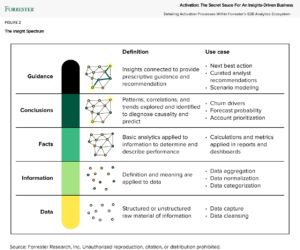Is Your B2B Organization Insights-Driven?
In Forrester’s Marketing Survey, 2023, 29% of B2B marketing decision-makers in Asia Pacific who are responsible for marketing operations say that their organization will support growth over the next 12 months by enhancing marketing’s use of measurement and analytics to drive insights and decision-making. APAC (Asia Pacific) B2B marketing decision-makers see data quality, data accessibility, and lack of business insights as their top challenges to achieving their marketing goals.
When looking at how organizations use data to try to be insights-driven, we see three types of firms:
- Data-aware. These companies build data warehouses or data lakes and invest in self-service analytics tools in the hope that good things will follow. They make data available for observation and exploration but struggle to turn data into signals and actions.
- Data-driven. These firms make investing in data and analytics a business strategy, not a technology response to business requirements. They turn data into signals using advanced analytics and reporting. They can create sophisticated visual and predictive signals but rely on reports and dashboards to suggest actions.
- Insights-driven. These companies invest in achieving their business’s strategic goals, which include gaining competitive advantage by generating and applying insights. They make insights pervasive and actionable from advanced analytics, employees, and customers, implementing them in all business operations and applications to drive actions.
Few organizations argue with the need to become insights-driven, but just what are insights, and how are they developed?
Just Having Data Is Not Enough
You only get insights by collecting relevant, high-quality data; systematically processing, analyzing, and summarizing it to produce high-quality information by applying a solid understanding of business context and practices; and using that intelligence to develop actionable conclusions, guidance, and recommendations. Large organizations spread the responsibility for these efforts among different people and teams. High-quality data is the foundation; business knowledge and processing capabilities are the keys to unlocking the power of that data. In the end, insights cover a spectrum from core data up to the guidance that your organization requires to grow.

If you’re not sure where your organization stands, here are some signals that can help you determine whether you have insights gaps:
- Analytics teams constantly complaining that they are overloaded
- Stakeholders struggling to interpret and digest the data
- Concerns about the quality of the data
- Existing technology that limits the ability to collect relevant data
- Lots of data available, but it yields few conclusions or recommendations
- Analytics teams struggling to define priorities and success criteria
Close Insights Gaps And Make Your Organization Insights-Driven
Closing insights gaps is about people, process, and technology. Developing analytics capabilities using good process design will lay the appropriate foundation.
When developing analytics capabilities, firms should always start with aligning analytics strategy and priorities with their business goals. Making sure to measure the right metrics with a healthy and balanced measurement system that reflects business objectives is critical, but so is setting up good processes to activate insights in the organization when they are identified. To support continuous improvement, organizations should also assess and invest in the right enabling technology, developing and balancing the skill sets their analytics teams need. Nevertheless, their work is never done: Constantly managing and optimizing performance must become a routine discipline.
Insights-Driven Organizations Get Better Results
Data and analytics decision-makers who say that their firms have advanced insights-driven business capabilities are 8.5 times more likely than those at firms at the beginner stage to report that their firm’s annual revenue grew by 20% or more. We commonly see advanced insights-driven firms sustain exponential revenue growth because they have operating models that depend on insights implemented in software and strategically invest in data, analytics, and insights. They ensure that insights are always actionable and make insights-to-action a team sport. And finally, these companies continuously experiment and learn.
Hear More At B2B Summit APAC
Forrester will host B2B Summit APAC 2023 on September 19 and 20. My session, “The State Of B2B Measurement,” will show you how to discover your insights gap, address marketing measurement challenges, and establish and enable insights-driven capabilities. Hope to see you there!
